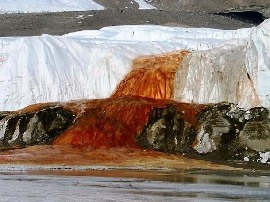
Mystery solved
In 1911, Australian geologist Griffith Taylor discovered the red waterfall known as Blood Falls, one of the most famous landmarks in Antarctica.
It occasionally pours its stunning blood-like water down the white ice of the Taylor Glacier making for great photo opportunities. The colour was originally thought to be red algae but was later discovered to be the result of iron that oxidizes when it hits the cold surface air.
The water in the falls is fed by an inaccessible sub-glacial pool beneath Taylor glacier that is around 1.5 million years old and contains at least 17 different types of ancient microbes and almost no oxygen.
There are two reasons why the water doesn’t freeze. Firstly, The water has a salinity two to three times that of ocean water and salty water freezes at a lower temperature than fresh water.
Secondly, the brine actually warms itself up as it freezes because when water changes, from liquid to frozen, it gives off heat. Some of the briny (salty) water does freeze, but in doing so, the heat given off allows the rest of the briny water to keep flowing.
Finding microbes in water trapped beneath a glacier gives hope for finding life in other places in our solar system such as Mars or frozen Europa (a moon of Jupiter).
These life forms, being buried under depths of ice would be protected from the harsh impact of ultraviolet and cosmic rays.
Antarctica is such an amazing place.

